mobile Ansicht, to the English Version tap the flag
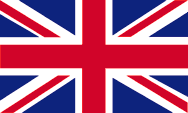

- Republik Seychellen
- präsidiale Republik
- Eigenbezeichnungen:
– Englisch: Republic of Seychelles
– Französisch: République des Seychelles
– Kreolisch: Republik Sesel
- andere Bezeichnungen:
– Französisch: Séchelles
– Deutsch: Seschellen
• Flaggen
• historische Flaggen
• Bedeutung/Ursprung der Flagge
• Wappen
• Bedeutung/Ursprung des Wappens
• Flugzeugkokarde
• Landkarte
• Zahlen und Fakten
• Geschichte
• Ursprung des Landesnamens
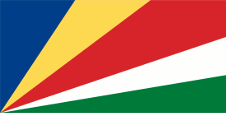
Nationalflagge,
Seitenverhältnis = 1:2,
Quelle, nach: Flags of the World





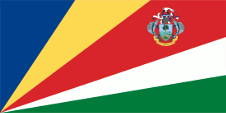
Flagge des Präsidenten,
Seitenverhältnis = 1:2,
Quelle, nach: Flags of the World




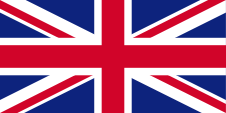
1794–1976,
Union Flag → quasi Nationalflagge,
Flagge von Großbritannien,
Seitenverhältnis = 1:2,
Quelle, nach: Wikipedia (EN)





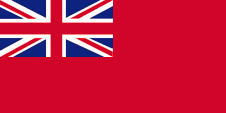
1865–1976,
Handelsflagge,
Seitenverhältnis = 1:2,
Quelle, nach: Flags of all Nations





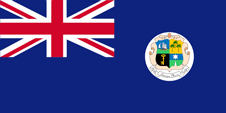
1882–1903,
Mauritius,
Flagge der Regierung (Staatsflagge),
Seitenverhältnis = 1:2,
Quelle, nach: Flags of the World



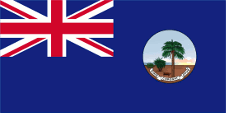
1903–1961,
Flagge der Regierung (Staatsflagge),
Seitenverhältnis = 1:2,
Quelle, nach: Flags of the World,
LadyofHats, CC0, via Wikimedia Commons



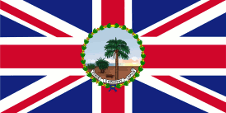
1903–1961,
Flagge des Gouverneurs,
Seitenverhältnis = 1:2,
Quelle, nach: Flags of the World,
LadyofHats, CC0, via Wikimedia Commons



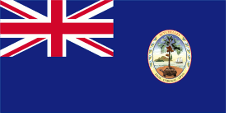
1961–1976,
Flagge der Regierung (Staatsflagge),
Seitenverhältnis = 1:2,
Quelle, nach: Flags of the World,
LadyofHats, CC0, via Wikimedia Commons



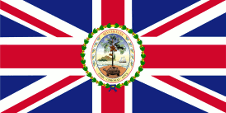
1961–1976,
Flagge des Gouverneurs,
Seitenverhältnis = 1:2,
Quelle, nach: Flags of the World,
LadyofHats, CC0, via Wikimedia Commons



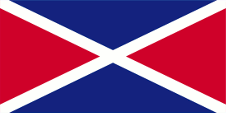
1976–1977,
Nationalflagge,
Seitenverhältnis = 1:2,
Quelle, nach: Flags of the World



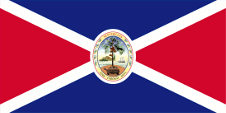
1976–1977,
Flagge des Präsidenten,
Seitenverhältnis = 1:2,
Quelle, nach: Flags of the World,
LadyofHats, CC0, via Wikimedia Common



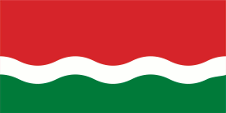
1977–1996,
Nationalflagge,
Seitenverhältnis = 1:2,
Quelle, nach: Flags of the World



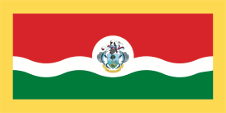
1977–1996,
Flagge des Präsidenten,
Seitenverhältnis = 1:2,
Quelle, nach: Flags of the World




Die heutige Flagge der Seychellen wurde am 08.01.1996 eingeführt. Sie zeigt die fünf Farben Blau, Gelb, Rot, Weiß und Grün, als Strahlen aus der linken unteren Ecke der Flagge ausgehend. Die Flagge soll eine aufstrebende und fortschrittliche Nation verkörpern. Blau steht für den Himmel und das Meer, Gelb für die Sonne und das Licht, Rot für das Blut, den Schweiß und die Tränen des Volkes, Weiß für Recht, Gerechtigkeit und Harmonie, Grün für die Landwirtschaft und die Vegetation. Die Farben der Flagge folgen offenbar folgenden Vorgaben in RGB: Blau = 0-63-135, Gelb = 252-216-86, Rot = 214-40-40, Grün = 0-122-61.
In der Flaggengeschichte des Landes weißt der Union Jack auf die früheren Verbindungen zu Großbritannien hin. Großbritannien hatte in Jahr 1864 ein Flaggensystem eingeführt, in dem:
• Kriegsschiffe einen sogenannten "White Ensign" (Marineflagge), eine weiße Flagge oft mit durchgehendem roten Georgskreuz und mit dem Union Jack in der Oberecke,
• Handelsschiffe einen "Red Ensign" (auch "Civil Ensign" → Bürgerflagge genannt, die eigentl. Handelsflagge), eine rote Flagge mit dem Union Jack in der Oberecke, und
• Dienstschiffe einen "Blue Ensign" (Regierungsflagge → die eigentl. Staatsflagge), eine blaue Flagge mit dem Union Jack in der Oberecke führten.
Seit 1865 durften Schiffe von Kolonialregierungen einen Blue Ensign mit einem Badge (Abzeichen) im fliegenden Ende führen. Die jeweiligen Regierungen sollten entsprechene Bagdes zur Verfügung stellen. Handelsschiffe und seefahrende Privatpersonen aus Kolonien dürfen nur dann einen Red Ensign mit Badge führen, wenn von der britischen Admiralität eine entsprechende Erlaubnis für die Kolonie erteilt wurde. Ein solches Badge war oft eine auf einer Scheibe platzierte regionale landschaftliche Darstellung, zeigte oft Schiffe, historische Begebenheiten oder konnte auch nur eine Art Logo sein. Auf der Seeflagge der Behörden der Britischen Seychellen (Blue Ensign) erschien seit 1903 ein Badge das eine Küstenlandschaft mit einer Palme und einer Schildkröte zeigt, dazu das Motto des Landes "Finis Coronat Opus". Im Jahre 1961 wurde das Badge ein wenig abgeändert: es wurde oval und zeigte in einem umlaufenden Rand außer dem Motto auch den Namen des Landes.
An Land repräsentierten der einzelne Bürger und auch die Behörden ihren Status als Bürger oder Organe der britischen Nation, verkörpert im United Kingdom, durch die Verwendung des Union Jack, dann „Union Flag“ genannt. Zur See war somit für den britischen Bürger die britische Handelsflagge, der Red Ensign (Rote Flagge) vorgesehen. In einigen wenigen Fällen wurde den Bürgern einer Kolonie durch die Admiralität erlaubt, auf See einen eigenen Red Ensign mit dem Badge der Kolonie zu verwenden. Für die Seychellen lag eine solche Erlaubnis jedoch nicht vor.
Diese Werte lassen sich wie folgt in Pantone-Farben interpretieren: Blau = pt 294, Gelb = pt 122, Rot = pt 1795, Grün = pt 356. Die erste Flagge der unabhängigen Syechellen zeigte die Farben der zwei Regierungs-Parteien des Landes in Form blauer und roter Dreiecke, die von einem weißen diagonalen Kreuz getrennt sind. Blau stand für die Demokratische Partei und Rot für die Vereinigte Volkspartei. Nach einem Putsch der Vereinigten Volkspartei im Jahre 1977 wurde am 05.09.1977 eine neue Flagge eingeführt. Sie zeigte das Design der Parteiflagge der Vereinigten Volkspartei (heute: Fortschrittliche Volksfront), rot und grün waagerecht gestreift, abgetrennt durch einen weißen Wellenstreifen, jedoch ohne aufgehende Sonne. Rot stand für Fortschritt, Revolution und Sozialismus, Weiß für die Strände und den Indischen Ozean, Grün für die üppige Pflanzenwelt der Inseln.
Quelle:
Die Welt der Flaggen,
Flaggen und Wappen der Welt,
Wikipedia (EN),
Flags of the World,
Flaggen Wappen Hymnen,
Volker Preuß

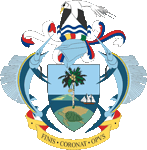
seit 1996,
Wappen der Seychellen,
Quelle: Corel Draw 4,
Wikipedia (EN)
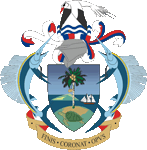
1976–1996,
Wappen der Seychellen,
Quelle: Corel Draw 4,
Wikipedia (EN)
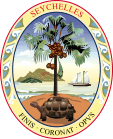
1961–1976,
Emblem (Badge) der Seychellen,
Quelle: Flags of the World,
LadyofHats, CC0, via Wikimedia Commons
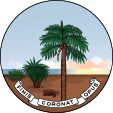
1903–1961,
Emblem (Badge) der Seychellen,
Quelle: Flags of the World,
LadyofHats, CC0, via Wikimedia Commons

Das heutige Staatswappen der Seychellen wurde anlässlich der der Unabhängigkeit des Landes am 27.05.1976 eingeführt. Es geht auf das im Jahre 1903 der Kolonie vom britischen König Eduard VII. verliehene Badge zurück, und zeigt auf dem Schild ein Stück Land, darauf eine Palme und darunter eine Riesenschildkröte. Im Hintergrund eine Insel und ein Segelschiff. Oberhalb des Schildes ein Helm mit weiß-blau-roten Bändern und darüber ein Faeton, ein hier heimischer tropischer Vogel. Schildhalter sind zwei Seglerfische. Auf dem Spruchband das lateinische Staatsmotto: "Finis Coronat Opus" → "Das Ende krönt das Werk". Im Jahre 1996 wurden einige farbliche Veränderungen vorgenommen.
Quelle:
Die Welt der Flaggen,
Flaggen und Wappen der Welt,
Wikipedia (EN),
Flaggen Wappen Hymnen,
Volker Preuß

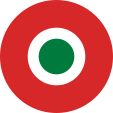
Flugzeugkokarde,
Quelle, nach: Wikipedia (EN)

Lage:

Quelle: CIA World Factbook
Landkarte des Landes:
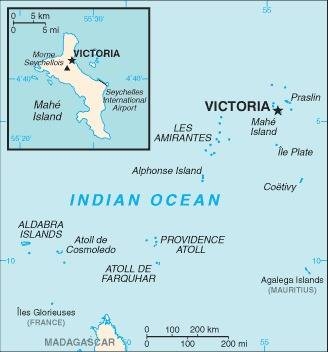
Quelle: CIA World Factbook
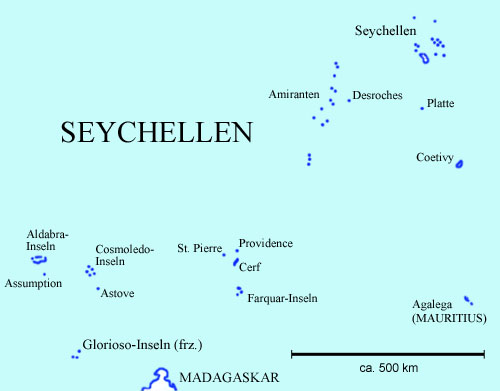
Landkarte/Map: Volker Preuß

Fläche: 455 km², bestehend aus: Seychellen-Gruppe, Amiranten-Inseln, Assumption-Insel, Astove-Insel, Coetivy-Insel, Cosmoledo-Inseln, Providence-Insel, Saint-Pierre-Insel, Cerf-Insel, Platte-Insel, Aldabra-Inseln und Farquhar-Inseln, insgesamt 115 Inseln, davon 36 bewohnt
Einwohner: 99.000 (2021), davon 91% Kreolen, 4% Inder, 0,5% Madagassen, 0,5% Filipinos, 3% andere, darunter auch Europäer und Afrikaner
Religionen: 76% Katholiken, 10% Protestanten und Anglikaner, 2% Hindus, 2% Moslems
Bevölkerungsdichte: 218 Ew./km²
Hauptstadt: Victoria, 26.500 Ew. (2010)
Amtssprachen: Englisch, Französisch, Seychellenkreol
Währung: 1 Seychellen-Rupie (SCR, SR) = 100 Cents
Zeitzone: MEZ + 3 h
Quelle:
Wikipedia (DE),
Encyclopedia Britannica Online

ca. 800 · arabische Seefahrer entdecken den heutigen Seychellen-Archipel, landen auf der Insel Silhouette und nennen sie "Aldabra" (Die Grüne)
1501 · der portugiesische Seefahrer Vasco da Gama entdeckt die unbewohnten Inseln südwestlich des heutigen Seychellen-Archipels und nennt sie "Admiralsinseln" (Amiranten), weitere portugiesische Indienfahrer entdecken wenig später den heutigen Seychellen-Archipel und nennen ihn "As sete irmas" (Die sieben Schwestern), oder auch "Os sete irmãos" (Die sieben Brüder)
1608 · die Britische Ostindien-Handelsgesellschaft erkundet und kartographiert die unbewohnten Inseln
1742 · Franzosen von der Île de France (Mauritius) erkunden die unbewohnten Inseln
1756 · der irische Kapitän Corneille Nicolas Morphey nimmt die Inseln im Auftrag des französischen Königs Ludwig XV. für Frankreich in Besitz und nennt sie nach Jean Moreau de Séchelles, dem königlichen Finanzminister
1768 · der französische Gouverneur der Île de France (Mauritius), gründet mit Mahé auf der gleichnamigen Insel die erste Siedlung auf den Seychellen, Anlage von Gewürz-Plantagen, Einfuhr von schwarzen Sklaven aus Afrika
ab 1770 · Besiedlung und wirtschaftliche Erschließung der Inseln Praslin, Silhouette, Félicité und La Digue sowie der Inselgruppen der Amiranten, der Aldabra-Inseln und der Farquar-Inseln
1794 · eine britische Flotte erscheint vor Mahé, die Inseln werden von Großbritannien annektiert, die Übergabe zieht sich bis 1811 hin, die Stadt Mahé wird in Port Victoria umbenannt
1812 · Abschaffung der Sklaverei
1814 · Erster Pariser Friede, Ende der Koalitionskriege (1813–1814) zwischen Frankreich (Napoléon) Großbritannien, Russland, Österreich, Preußen und Schweden, Großbritannien gibt einige im Verlauf des Krieges besetzte französische Kolonien zurück, erhält jedoch die Syechellen offiziell zugesprochen, diese werden nun auch als Strafkolonie und Verbannungsort genutzt
1882 · die Seychellen, die bisher von Mauritius aus verwaltet wurden, werden eine Dependenz von Mauritius, sie erhalten einen eigenen Kommissar, der jedoch dem Gouverneur von Mauritius unterstellt ist
1903 · die Seychellen werden von Mauriritus getrennt und werden britische Kronkolonie mit einem eigenen Gouverneur
1948 · den Seychellen wird innere Autonomie gewährt, Wahl eines Inselrats
1964 · Gründung der „Seychelles People's United Party“ (SPUP) durch den Anwalt France-Albert René, Forderung nach Unabhängigkeit für die Seychellen
1965 · Gründung der „Seychelles Democratic Party“ (SDP) durch den Anwalt James Mancham, Forderung für einen Verbleib der Seychellen bei Großbritannien
1965 · die Aldabra-Inseln, die Farquar-Inseln, sowie die Inseln Desroches, Platte und Coetivy werden mit dem 1500 km entfernten Chagos-Archipel zum "Britischen Territorium im Indischen Ozean" zusammengeschlossen
1967 · ersten allgemeine und freie Wahlen, Sieg der SDP
1970 · Wahlen, Sieg der SDP, James Mancham wird Premierminister
1974 · Wahlen, Sieg der SDP
1975 · den Seychellen wird volle innere Autonomie gewährt
28.06.1976 · den Seychellen wird Unabhängigkeit im Rahmen des Commonwealth of Nations gewährt, die Aldabra-Inseln, die Farquar-Inseln, sowie die Inseln Desroches, Platte und Coetivy werden von Großbritannien an die Seychellen abgetreten, James Mancham wird Präsident, France-Albert René wird Premierminister
07.06.1977 · Putsch der Vereinigten Volkspartei (SPUP), Premierminister France-Albert René ergreift als Präsident die Macht, James Mancham geht ins Exil nach Großbritannien
1978 · die SPUP benennt sich um in SPPF, Einführung des Einparteiensystems
1981 · Putschversuch südafrikanischer Söldner, Kreolisch wird als Landessprache anerkannt
1991 · Wiedereinführung des Mehrparteiensystems
1992 · James Mancham kehrt auf die Seychellen zurück
1993 · Verfassungsreform
Source: Atlas zur Geschichte,
Wikipedia (D),
World Statesmen

Der unbewohnte Seychellen Archipel wurde wahrscheinlich 1502 von portugiesischen Indienfahrern entdeckt und "As sete irmas" (Die sieben Schwestern), oder auch "Os sete irmãos" (Die sieben Brüder) genannt. Schon 1501 entdeckte Vasco da Gama die unbewohnten Inseln südwestlich des heutigen Seychellen-Archipels und nannte sie "Admiralsinseln" (Amiranten). Als der irische Kapitän Corneille Nicolas Morphey den Seychellen-Archipel im Jahre 1756 im Auftrag des französischen Königs Ludwig XV. für Frankreich in Besitz nimmt, nennt er ihn nach Jean Moreau de Séchelles, dem königlichen Finanzminister. Das Motiv dafür ist nicht klar.
Source: www.indian-ocean.com


![]()















































